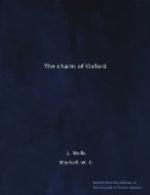The Library was built by the munificence of Bishop Reed of Chichester between 1377 and 1379; the dormer windows, however (seen in Plate VII), are later in date. The bookcases in the larger room were made in 1623; one of the original half cases, however, was spared, that nearest to the entrance on the north side, and this is the most interesting single feature in the whole library. It need hardly be said that the reading-desk in early times was actually attached to the bookcase; the library then was a place to read in, not one from which books were taken to be read. The books were to be kept “in some common and secure place,” and they were “chained in the library chamber for the common use of the fellows” (J. W. Clark).
The old case that has been retained still has its chained books, and traces of the arrangement for chains can be seen in the other cases. Merton was one of the last libraries in Oxford to keep its books in chains; these were only removed in 1792; in the Bodleian the work had been begun a generation earlier (in 1757).
Not all books, however, were chained; by special arrangements in old college statutes, some of them were allowed out to the fellows. The register of Merton contains interesting entries as to how the books were distributed, e.g. on August 26, 1500, “choice was made of the books on philosophy; it was found there were in all 349 books, which were then distributed.” This was a large number: at King’s, Cambridge, less than half a century before, there were only 174 books on all subjects, and in the Cambridge University Library in 1473, only 330.
If a book was borrowed, great precautions were taken; the Warden of Merton in 1498 had to obtain the leave of the college to take out a book which he wanted; then, “in the presence of the four seniors,” he received his book, depositing two volumes of St. Jerome’s Commentaries as pledges for its safe return. A similar ceremony, with a similar entry in the register, marked the replacement of the book in the library. Though printing was already beginning to multiply books, yet then, and for long after, a book was a most valuable possession. The features of these venerable tomes are well described by Crabbe:
“That weight of wood,
with leathern coat o’erlaid,
Those ample clasps,
of solid metal made,
The close pressed leaves,
unclosed for many an age,
The dull red edging
of the well-filled page,
On the broad back the
stubborn ridges rolled,
Where yet the title
shines in tarnished gold,
These all a sage and
laboured work proclaim,
A painful candidate
for lasting fame.”
Such books are numbered by hundreds in every college library, and it is only too true of them that:
“Hence in these times,
untouched the pages lie
And slumber out their
immortality.”
The reception of such a book in a library was an event, and the record of one gift occupies six whole lines in the Merton Register; its donors are named as “two venerable men,” and the entry sweetly concludes, “Let us, therefore, pray for them.”




